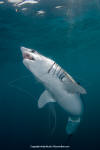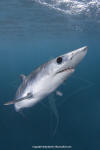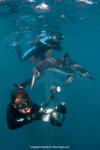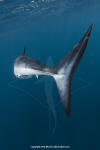|
|
|
SHARK INFO |
|
SHARK |
|
SHARK EVOLUTION |
|
|
|
SHARK DIVING |
|
SHARK DIVING 101 |
|
|
|
CONSERVATION |
|
|
|
PHOTOGRAPHY |
|
SHARK PHOTO TIPS |
|
|
|
RESOURCES |
|
|
|
WEB STUFF |
|
WHAT IS ELASMODIVER? Not just a huge collection of Shark Pictures: Elasmodiver.com contains images of sharks, skates, rays, and a few chimaera's from around the world. Elasmodiver began as a simple web based shark field guide to help divers find the best places to encounter the different species of sharks and rays that live in shallow water but it has slowly evolved into a much larger project containing information on all aspects of shark diving and shark photography. There are now more than 10,000 shark pictures and sections on shark evolution, biology, and conservation. There is a large library of reviewed shark books, a constantly updated shark taxonomy page, a monster list of shark links, and deeper in the site there are numerous articles and stories about shark encounters. Elasmodiver is now so difficult to check for updates, that new information and pictures are listed on an Elasmodiver Updates Page that can be accessed here:
|
|
_ |
|
Macho Mako First published in Diver Magazine April 2010
Every shark species has a collective personality. Shortfin mako sharks come
in fast and mouth everything in sight. In their initial enthusiasm they
often ignore the bait completely and bite the outboard engines instead.
Unfortunately for photographers, their mouthing mode rarely lasts more than
a few minutes. In the time that it takes to gear up and slip into the water,
the action is usually over. Once they
calm down, mako sharks enter a more cerebral state. They swim around slowly
at a distance, probably trying to understand where the delicious aroma is
really coming from. At this stage, if you�re a photographer looking for the
quintessential gape shot, you�re unlikely to succeed. I�ve been
trying to nail that shot for years. On my last attempt I finally encountered
the type of fearless mako shark that photographers dream about. I was in San
Diego working with mako expert Walter Heim. Walter was once an avid
recreational shark fisherman but when he noticed a significant decline in
blue and mako shark numbers, he traded his rods for a tagging pole and an
underwater camera. Now an accomplished photographer, Walter spends most of
his summer weekends drifting off the coast of Southern California in a small
aluminum boat. I met Walter
and two other divers on a cool September morning in Mission Bay. We motored
westward at a good clip until we were ten miles out from La Jolla Shores.
The sun was hidden behind a grey blanket of clouds and the sea looked cold
and uninviting. Walter suspended a small bucket of frozen fish scraps from
the starboard rail and deployed a sea anchor to stop the wind from dragging
us away. Then we sat in silence and waited. While fish
scales drifted away in the departing chum slick like a trail of tiny bread
crumbs, Walter talked about his �hand camming� technique. Rather than
plunging in like the rest of us, Walter holds his camera over the transom
and shoots blindly in the direction of the shark. There are some obvious
compositional drawbacks with this method but it�s a good way to rattle off a
few shots while the sharks are still interested. It was a
while before any sharks caught our scent but eventually Walter spotted a
slate grey fin snaking towards the boat. Mayhem ensued while I ignored
Walter�s advice and clumsily jumped into the water with snorkel and fins
more or less in place. True to
form, by the time I got my bearings the two meter mako which had left some
respectable gouges in the ship�s propeller, was swimming away at a casual
pace. I bobbed
around for a minute or two willing it to return, and to my surprise it
slipped back into view and swam towards me. Walter tossed a small mackerel
in its general direction and the little mako changed gear and engulfed the
sprat before I had a chance to react. Makos move
like bullets when they are chasing a meal. They have been compared to race
horses, cheetahs, eagles, Ferraris, fighter jets and just about every other
fast moving entity. But, when it comes to speed, the power that makos
display has no terrestrial comparison. Consider this; cheetahs (the fastest
animals on land) are capable of sprinting at about 120kph. When in a power
dive, the peregrine falcon can hit 300kph with a little help from gravity.
That is pretty impressive until you consider that peregrine falcons are only
flying through air. Shortfin makos have been recorded at 56kph, which is
undeniably slower, but water is almost 800 times denser than air at sea
level. Resistance-wise, that�s like flying at 44,000kph! They can do
this because of their chiseled hydrodynamic profile and their extremely
efficient red muscle mass. Like other mackerel sharks and some game fish,
makos have a specialized vascular network called a rete mirabile
(wonderful net in Latin) which acts as a counter-current heat exchanger. By
sending pre-warmed, oxygen rich blood to their muscles, more energy can be
converted into raw power. Next time
Walter tossed a fish towards the mako, I waited for the burst of speed and
then finned in from the other direction as fast as I could kick. The mako
snapped up the fish and then swam straight at me with its mouth wide open.
That was a reaction that I hadn�t expected but I instinctively knew what it
meant; �Back off. These fish are mine!� It was a
classic threat display. The mako was trying to intimidate its perceived
rival by flashing its impressive dentition. A larger shark may have taken it
to the next level (more fool me for getting in its way) and a smaller shark
would probably have turned tail and fled. But in this shark�s brain I was
its physical equal so the fish were fair game for whoever got to them first.
Walter
tossed a third fish and I closed the gap as quickly as I could. The mako
streaked in, took the mackerel and then shot towards me mouth agape. I
started firing away. As I did so, my whining strobes had a bizarre effect.
The mako stalled right in front of me and started quivering its jaws. Either
this was an extension of its previous threat display or the shark�s keen
senses were overwhelmed by the powerful electrical discharges. Never once
did he actually bite down on my camera. As long as my strobes continued to
fire the mako remained in front of my dome port, swimming slowly forward as
I back peddled at the same pace. As soon as I stopped shooting he turned and
disappeared. We repeated
this dance a couple more times. The other divers slipped in beside me and I
did my best to compose a few shots rather than just using my camera as a
shield.
The shark�s
close proximity made framing each image a bit challenging even with a
fisheye lens. I could fib about the photographic finesse I showed that day
but in reality it was a very haphazard affair that happened to yield some
spectacular results. Later,
Walter who has encountered hundreds of makos in the wild, confirmed my
suspicion that this was a very special shark. Rarely is a diver afforded
such a sustained display of bravado. After
decades of over-fishing, encounters with makos and blues in Southern
California are no longer guaranteed. A few years ago the last commercial
shark dive operator hung up his fins for good, but there are still a few
sharks out there for divers with their own boats and a little ingenuity. Go while you
still can. Even though many recreational fishermen now practice catch and
release, makos grow rarer every year. One reason is the demand for mako
steaks especially in Italy which is the biggest importer of mako meat in the
world. After decimating its domestic population, Italy now imports much of
its meat from France, Spain, Northern Europe and South America. Makos are
also relentlessly fished by Asian long-liners. Mako fins are highly prized
because of the length and quality of the noodles that their fibers produce.
Regional
fishing bans are generally ineffective because of the mako�s migratory
nature. Once they enter international waters they are fair game for any
fishing boats that are waiting for them. Fortunately,
there is now a powerful lobbying group called the Shark Alliance that is
pushing for stricter protection at a global level. If you want
to do your part, consider joining a local conservation group such as The
Shark Safe Network which promotes catch and release and encourages marinas
to ban the landing of sharks completely. For a list
of conservation groups working to protect sharks please visit:
http://elasmodiver.com/protectingsharks.htm
Author:
Andy Murch
Andy is a Photojournalist and outspoken conservationist specializing in
images of sharks and rays. RETURN TO SHARK STORIES MAIN PAGE |
































